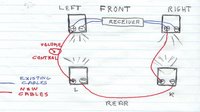
If you didn't want to risk half a grand or more on a quad set without knowing which format of LP would prevail, you could do what many of us did: use a "Hafler Hookup” to simulate four-channel sound in your home or car. All it took was that set of old speakers you had hanging around the basement, some wire, and maybe a cheap volume control from Radio Shack. I did it based upon a diagram I saw in Stereo Review. See my professional-looking commercial-quality drawing above. Note to you kids at home: try this at your own risk; I don’t want to hear from you if you short out your receiver.
The HH was named for the guy who came up with this elegantly simple idea. You set up a cheap set of speakers in the rear or side of your listening area. Since the rear speakers would mostly be used for ambiance and special effects you did not need to spend money on anything fancy. Then you ran wires from the front speakers to the rear ones in such a way that the signals reaching the back speakers canceled each other out. What you then heard coming from behind was the difference between the sound intended for the left speaker with that meant for the right. The volume control was intended to lower the sound of the rear speakers, which, because they were typically smaller, would otherwise sound louder than their front counterparts.
How did it sound? That depended upon the recording. In a conventional stereo recording you get a sense that the sound is coming from different directions in front of you; this occurs because the sound coming from the two speakers differs. If you listened to a solo guitarist recorded in a studio, there wasn’t much of a stereo effect in the first place, and a Hafler rig wouldn't have much signal difference to send to the rear speakers. Put on a classical album recorded in Carnegie Hall and the rear speakers would capture the ambiance and crowd sounds in such a way that you might think you were in the middle of the audience. It even worked with comedy albums; you’d hear the sounds of applause and laughter coming from all around you. But the most unusual sounds you could get from the HH were when you played a record in which multiple instruments were recorded separately and mixed together – as most rock, R and B and country albums are. You might suddenly hear a guitar coming from behind you, or a snare drum, or some strange sound effect. If the producer was really creative you might even hear the instruments moving about the room.

0 Comments:
Post a Comment
Subscribe to Post Comments [Atom]
<< Home